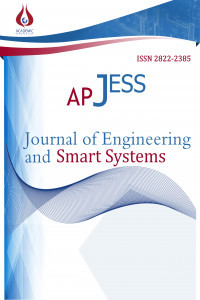An Expert System to Predict Eye Disorder Using Deep Convolutional Neural Network
Uzman Sistem, Glokoma, derin öğrenme, Göz Hastalığı, Gözdibi Görüntüsü
An Expert System to Predict Eye Disorder Using Deep Convolutional Neural Network
Expert System DCNN, Glaucoma, deep learning, Eye disease, Fundus İmages,
___
- Xu, Y., Lin, S., Wong, T.Y., Liu, J., Xu, D.: Efficient ReconstructionBased Optic Cup Localization for Glaucoma Screening. In: MICCAI 2013
- C. Bowd, R. N. Weinreb, J. M. Williams, and L. M. Zangwill, “The retinal nerve fiber layer thickness glaucomatous eyes with galucoma optical coherence tomography on Fundus and normal Images,” Archives of ophthalmology, vol. 118, no. 1, pp. 22–26, 2017.
- Space healthcare. Understanding glaucoma. http://space-healthcare.com/wp-content/uploads/2015/02/glaucoma-300x197.jpg.
- Hinton, G.E., Srivastava, N., Krizhevsky, A., Sutskever, I., Salakhutdinov, R.R.: Improving neural networks by preventing co-adaptation of feature detectors. In: Arxiv 2012
- Ciresan, D.C., Meier, U., Masci, J., Gambardella, L.M., Schmidhuber, J.: High-performance neural networks for visual object classification. In: Arxiv 2011
- Xu, Y., Xu, D., Lin, S., Liu, J., Cheng, J., Cheung, C.Y., Aung, T., Wong, T.Y.: Sliding Window and Regression based Cup Detection in Digital Fundus Images for Glaucoma Diagnosis. In: MICCAI 2011
- R. R. Selvaraju, M. Cogswell, A. Das, R. Vedantam, D. Parikh, and D. Batra, “Optic nerve head of non-glaucoma and glaucoma eye via gradient-based localization,” in Proceedings of the IEEE International Conference on Computer Vision, pp. 618–626, 2017.
- P. J. Foster, R. Buhrmann, H. A. Quigley, and G. J. Johnson, “The definition and classification of glaucoma in prevalence surveys,” British journal of ophthalmology, vol. 86, no. 2, pp. 238–242, 2015.
- S. Ahmed, O. Uçan, Adil Deniz Duru, Oğuz Bayat, “Breast Cancer Detection And Image Evaluation Using Augmented Deep Convolutional Neural Networks”, Aurum Mühendislik Sistemleri ve Mimarlık Dergisi, Vol. 2, No. 2, Pp. 121–129, 2018.
- J. De Fauw, J. R. Ledsam, B. Romera-Paredes, S. Nikolov, N. Tomasev, S. Blackwell, H. Askham, X. Glorot, B. ODonoghue, D. Visentin, et al., “Clinically applicable deep learning for diagnosis and referral in retinal disease,” Nature medicine, vol. 24, no. 9, p. 1342, 2018.
- F. Iandola, M. Moskewicz, S. Karayev, R. Girshick, T. Darrell, and K. Keutzer, “Densenet: Implementing efficient convnet descriptor pyramids,” arXiv preprint arXiv:1404.1869, 2014.
- Y. Wu and K. He, “Group normalization,” in Proceedings of the European Conference on Computer Vision (ECCV), pp. 3–19, 2018. Available Online: https://www.kaggle.com/kondwani/eye-disease-dataset.
- Available Online: https://www.kaggle.com/kondwani/eye-disease-dataset.
- Malik, S.; Kanwal, N.; Asghar, M.N.; Sadiq, M.A.A.; Karamat, I.; Fleury, M. Data Driven Approach for Eye Disease Classification with Machine Learning. Appl. Sci. 2019, 9, 2789.
- D. G. Duru and A. D. Duru, "MR-MS Image Classification based on Convolutional Neural Networks," 2019 Scientific Meeting on Electrical-Electronics & Biomedical Engineering and Computer Science (EBBT), Istanbul, Turkey, 2019, pp. 1-4, doi: 10.1109/EBBT.2019.8741752.
- D. G. Duru and A. D. Duru, "Classification of Event Related Potential Patterns using Deep Learning," 2018 Medical Technologies National Congress (TIPTEKNO), Magusa, 2018, pp. 1-4, doi: 10.1109/TIPTEKNO.2018.8597016
- Yayın Aralığı: Yılda 3 Sayı
- Başlangıç: 2022
- Yayıncı: Akademik Perspektif Derneği
Mehmet Zahid YILDIRIM, Caner ÖZCAN, Okan ERSOY
Ortoper Bulanık Kümelerle Bir Karar Verme Yaklaşımı: Ortoper Bulanık TOPSIS Metodu
Tongue-Operated Biosignal over EEG and Processing with Decision Tree and kNN
Kutlucan GÖRÜR, Mehmet Recep BOZKURT, Muhammed Serdar BASCIL, Feyzullah TEMURTAS
An Expert System to Predict Eye Disorder Using Deep Convolutional Neural Network
Moahmmed Rashid AHMED, Saadaldeen Rashid AHMED, Adil Deniz DURU, Osman Nuri UÇAN, Oğuz BAYAT
Esra GENCELİ, Gülsüm ÜRPER, Reyhan ŞENGÜR, Türker TÜRKEN, İsmail KOYUNCU
Şev Stabilitesi Probleminin Geri Analizle Çözümü: Örnek Bir Vaka
Zainab ABBOOD, Mahmoud SHUKER, Çağatay AYDIN, Doğu Çağdaş ATİLLA
Çarpık Dağılımlar için Çarpıklık Düzeltmesi Yöntemine Dayalı X ve R Kontrol Grafikleri
Sevgi YURT ÖNCEL, Handan ÖZARSLAN
Döküm Sanayinde Süreç Tabanlı Temel Gösterimleri İle İstatistiksel Süreç Kontrolü
